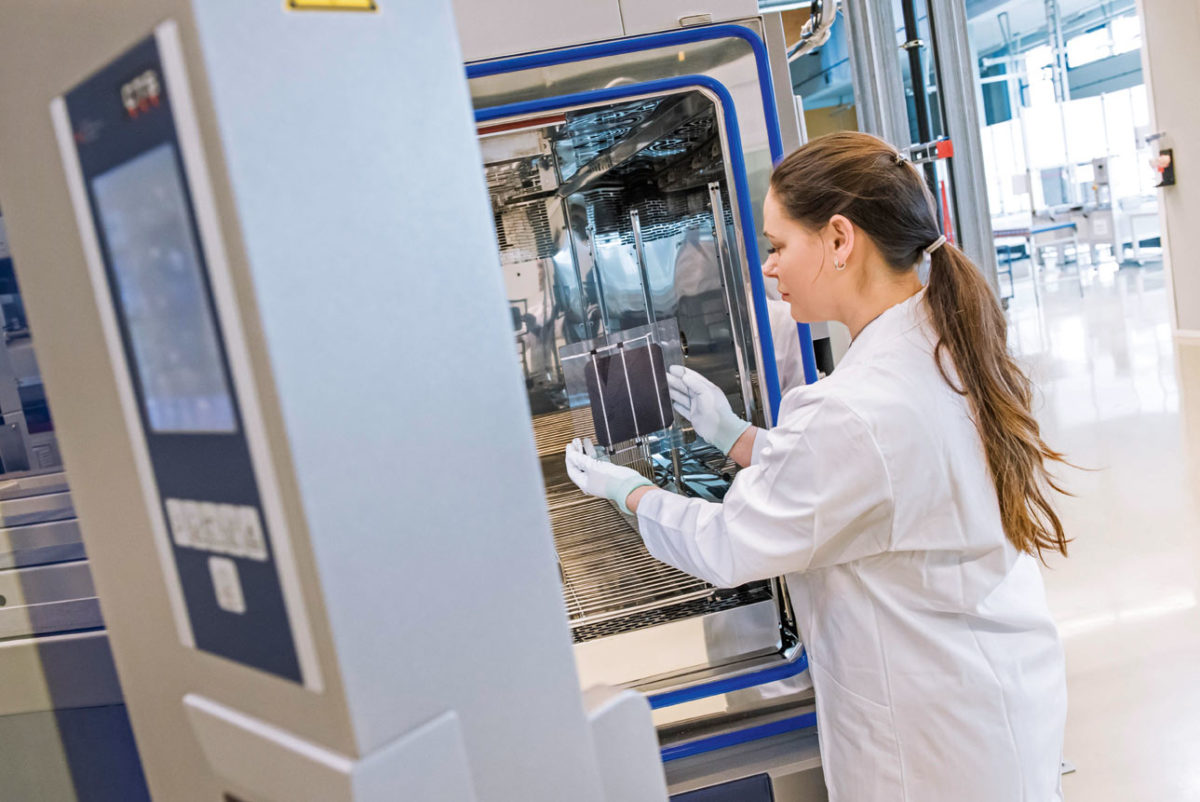From pv magazine, November 2019 issue
 The breakneck speed at which perovskite solar cells are reaching commercial maturity is invigorating its research community, but it is also raising concerns among some of its members, who fear that health and safety standards may not be advancing as rapidly as cell performance and fundraising campaigns. While some researchers help to assemble the first perovskite solar cell production lines, others question the wisdom of mass producing a technology that contains lead as a key active ingredient.
The breakneck speed at which perovskite solar cells are reaching commercial maturity is invigorating its research community, but it is also raising concerns among some of its members, who fear that health and safety standards may not be advancing as rapidly as cell performance and fundraising campaigns. While some researchers help to assemble the first perovskite solar cell production lines, others question the wisdom of mass producing a technology that contains lead as a key active ingredient.
Health hazards
“The health threat raised by lead used in perovskite solar cells is very serious,” said Professor László Forró at the École Polytechnique Fédérale de Lausanne (EPFL) in Switzerland. “And it remains largely neglected by the scientific community.”
In 2016, Professor Forró took part in a cytotoxicity study that showed lead particles in perovskite solar cells kill neurons and alter gene expression in living skin cells. He says that these results are no news to toxicologists.
The European Chemical Agency (ECHA) has warned that exposure to lead can notably cause cancer, damage organs and harm children. It also includes 32 lead-containing compounds in its list of substances that are of very high concern for authorization.
“Lead is a very serious poison, there is no doubt about it,” said Michael Grätzel, who pioneered dye-sensitized solar cells and other thin film PV technologies at EPFL. “The trouble with perovskite materials is that their lead compound is soluble in water.” Unlike lead in car batteries, this solubility helps the metal seep into the environment and contaminate living organisms.
Researchers and startups are now running tests on the safety of perovskite solar cells. But the task is daunting, all the more so given the variety of molecular formulations and lead mixtures used in this emerging technology.
“What hasn’t been done so far has been to track the many forms of contamination,” said Grätzel, who took part in the EU-funded FutureNanoNeeds project to assess the impact of nanomaterials on living organisms. “What happens if you ingest lead from these solar cells orally, if it seeps in through your skin, if you inhale it?”
Bert Conings, a physicist working on perovskites at Hasselt University in Belgium, recently retraced the history of lead-poisoning from a range of applications, from plumbing in the Roman Empire to toxic paints and gasoline in modern times. He reported a sobering trend of flaws in health and safety assessments.
“Humanity has made the mistake of incorporating lead in technology time after time,” he said. “We have come to a point where we have to accept that it is a bad idea to incorporate lead in anything at all.”
Law of the lead
In 2003, the EU passed legislation that heavily restricted the use of lead in consumer products. Public safety rules tend to be more stringent in Europe than in other parts of the world, but lead pollution is a sensitive issue for lawmakers in the United States, Japan and China, as well, and manufacturers across the globe tend to align with EU standards to continue selling in its market.
However, Conings points out that even the EU provides several products with exemptions to its lead restriction. As a result, materials containing undesirably high concentrations of lead can still find their way into European markets. As of 2011, photovoltaic modules benefit from one such exemption.
“If legislation stays as it is, there is no legal obstacle that we can perceive to bringing our perovskite solar cells to market,” said Henry Snaith, a University of Oxford professor and co-founder of Oxford PV. His company is equipping its first commercial-scale manufacturing line in Brandenburg an der Havel, Germany, and plans on launching production by the end of 2020.
Michael Saliba, a researcher working on the stability of perovskite materials and their incorporation into biomedical applications at TU Darmstadt and Forschungszentrum Jülich in Germany, explained that these exemptions are in place to avoid stifling innovation. This is particularly important for industry sectors such as renewable energy, where progress could provide invaluable benefits to society.
“It is hard to determine a safe limit for using water-soluble lead and the EU would ultimately prefer to avoid using it completely, but they don’t want to ban the material straight out,” he explained. “Lead has physical and chemical properties that cannot easily be replaced.”
No substitute
In recent years, researchers have attempted to substitute lead in perovskite solar cells with metals such as tin, germanium, bismuth, antimony, copper, manganese and titanium. So far, these attempts have achieved only comparatively modest energy conversion efficiencies. “Combinations based on tin can reach performances of around 11%,” said Nitin Padture, a professor who develops lead-free perovskite materials at Brown University in the United States. “The record with lead is 25%. We’re nowhere near that.”
He explains that lead is important because of its position in the periodic table. When incorporated in the crystal structure of a perovskite, the metal gives rise to an unusually high light absorption coefficient. Lead also avoids introducing deep electronic defects in perovskite layers that cause charges generated by the solar cell to recombine.
Researchers are investigating different alloys and whether redesigning the structure of the perovskite material can help optimize its physical properties, but Padture says that the jury is still out on how successful these approaches will be.
“As a scientist, you never say never,” he said. “We should keep trying. But lead has some very attractive properties. An alternative would be to make sure we contain it properly and prevent exposure as much as possible.”
Responsible compromise
Padture goes on to explain that compromises are inevitable in health and safety evaluations. He points out that perovskite solar cells use minute amounts of lead, less in fact than can be found in the solder of comparable silicon solar modules.
This year, researchers at Drexel University calculated that, under conservative estimates for lifetime and energy conversion efficiency, perovskite solar cells could in principle reduce lead emissions by a factor of two to four, compared to the existing electricity mix in the United States, by offsetting emissions of the metal from coal power plants. Professor Jason Baxter, who took part in the study, adds that careful industrial hygiene, reliable encapsulation in glass-glass modules, and controlled deployment and recycling programs will all prove critical to managing the risk of using lead and protecting individuals at a local level.
Likewise, Padture argues that it would be irresponsible to place lead-containing perovskite solar cells directly in the hands of end-consumers (think rooftop systems and portable rechargers). But he is less reserved about applications in which trained professionals control how the modules are treated and disposed of.
“Lead is toxic but if you have a big solar farm with a protective membrane on the ground and you recycle the panels, you could control its use and mitigate its risks,” he said.
Pragmatic assessment
According to Snaith, this is where legislation is most urgently needed. At present, the EU believes that the environmental benefits of deploying PV outweigh the ecological and health risks raised by the small volumes of lead used in perovskite materials. However, it could also mandate more robust safety standards for manufacturers of perovskite solar cells and demand clear and well-funded company policies for recycling solar panels at the end of their lifetime.
Oxford PV is adopting established glass-glass lamination techniques that have 25 years of proven stability in the field when used with other PV technologies. The company is also identifying recycling schemes insured by third parties and plans on factoring their cost into the price of their product.
“Recycling perovskite solar cells is a very simple process,” said Pablo Docampo, who works on the sustainability of perovskite solar cells at Newcastle University. “It just requires three big vats of non-toxic solvents and a room with proper air ventilation.”
Responsible compromise
Experts on perovskite solar cells still disagree on how lenient the authorities should be with respect to the use of lead in consumer products. But they tend to agree on the importance of measures that protect consumers.
“Neglecting lead and its hazards in perovskite materials would be irresponsible,” said Buyi Yan, founder of Microquanta, a perovskite solar cell manufacturer based in Hangzhou, China. “Yet with lessons learned from other technologies, ways to safely handle it will come with the product.”
Even past hawks on lead use are warming to the prospect of adopting it responsibly. “Initially I was of the opinion that we have to get rid of lead completely,” said Grätzel. “As the years go by, I increasingly think that if the panels are contained in a glass layer, operated in a controlled environment and recycled at the end of their life, that would be a solution.”
In 2020, the European Commission will revise its policy on toxic materials and exemptions for lead-containing products. Lawmakers elsewhere will be looking at scientific evidence from toxicologists, materials scientists and the PV community, but they also assess broader implications for society.
“There is such a strong environmental argument in favor of photovoltaics, offsetting many worse hazards than the potential risk of lead pollution,” said Oxford PV’s Snaith. “We are not dismissing this risk, we just want to manage it sensibly.”
This content is protected by copyright and may not be reused. If you want to cooperate with us and would like to reuse some of our content, please contact: editors@pv-magazine.com.



Great journalism here, captures all of the different aspects of the lead issue In perovskites. What’s interesting is that lead is used in conventional crystalline solar modules with the same packaging scheme that many in the perovskite world will be using. And glass glass modules such as First Solar demonstrates both crystalline and cadmium telluride modules are handling these materials without reported problems. This is an important issue for our industry to get right and past module history is showing that responsible and verifiable approaches that are working.
Well – if lead is a problem – what about Cd and Te ?